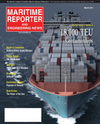
Page 61: of Maritime Reporter Magazine (March 2011)
Ship Repair & Conversion
Read this page in Pdf, Flash or Html5 edition of March 2011 Maritime Reporter Magazine
from navigation, these also cover alarm, monitoring and control, propulsion con- trol and power management options for vessels of all types and sizes.
The Platinum series is based on identi- cal components and a common network to provide all navigation functions as well as those for alarm, monitoring and control, propulsion control and power management. A combination of net- worked architecture and modular compo- nents provides unrivalled levels of system scalability so that solutions can extend from a small alarm-type system or a stand-alone ECDIS format to very large, complex configurations for sophisticated vessels such as megayachts and cruise- ships. Other main advantages of the Plat- inum series with its system-wide use of standardised hardware and software in- clude significant improved levels of ease of performance and reliability, enabling crews to concentrate on managing ships safely without undue distraction or stress.
Similarly, mainte- nance requirements are greatly simplified with a much-reduced requirement for spare parts, while continuity of operation is assured by extremely high levels of redundancy supported by exten- sive self-monitoring facilities and online diagnostics.
MARIS has secured what is believed to be the world’s first type approval certifi- cation for an independent PC-based radar kit to meet the new Radar Performance
Standard (MSC.192(79).
The certification recognizes the
MARIS Radar Kit as an integral part of a
Radar system, type approved to the latest standards associated with Radar Test
Standard IEC 62388.
The new Radar Performance Standard
MSC.192(79) and IEC 62388 encompass rigorous performance requirements for marine radar, particularly in terms of tar- get detection in adverse weather condi- tions where small targets are often barely visible to the radar system.
Steinar Gundersen, MARIS Deputy
Chief Executive (Corporate), said that the company had worked with some of the world's most experienced marine radar experts to develop its new PC Radar Kit.
With the MARIS PC Radar Kit already in use by system integrators in Europe, the Americas and Asia, certification rep- resented a landmark for the ability of in- dependent companies to compete on performance with complete radar system suppliers, he said. The kit includes a PCI card (Radar interface board, RIB) and the necessary radar software; it operates on a
Microsoft XP platform in a PC environ- ment and has the capability to interface with a majority of leading radar and nav- igation sensors. “The new Radar Stan- dards require that any approved radar must be tested as a system and therefore where appropriate, it is also necessary for equipment integrating with the radar kit to be tested and certified by an approved test authority,” he said.
Raytheon Anschütz plans to introduce to the industry by year’s end a new steering control sys- tem, NautoSteer AS, which is based on
CAN-bus technology, whereas all important components such as follow-up amplifiers, autopilots, interface units and alarm moni- toring units are con- nected via redundant
CAN-bus systems.
This is important, claims the manufac- turer, because in case of a failure, the steering control system switches auto- matically to a redundant CAN- bus, pro- viding secure data communication and built-in whole system reliability. As it serves as one of the more critical techni- cal areas onboard a vessel, NautoSteer
AS was developed with regard to fail-to- safe principles. Thanks to its integrated steering failure and wire-break monitor- ing, the steering control system perma- nently monitors actual rudder with set rudder and wire breaks to prevent from any unwanted rudder actions such as hard rudders which may cause damages to ship, loading or passengers. In addition, an integrated data integrity monitoring ensures that inconsistencies within the steering system do not necessarily de- grade the performance of the system. As another safety-relevant benefit a new and simplified steering mode selector switch separates an independent “Main” non- follow-up steering position from a “Sec- ondary” steering position with CAN-bus based autopilot or follow-up and non-fol- low-up bustiller controls.
The value of being able to detect small vessels approaching in any weather con- ditions, and automatically identify poten- tially hostile behavior, is highlighted by a report of piracy in 2011’s first edition of ‘Maritime Feedback’ (issue 28), a newsletter from CHIRP (www.chirp.co.uk). The ‘lesson learned’ was that a careful radar watch should be kept on areas of thick low clouds and rain, adjusting range and rain clutter ac- cordingly, the watchkeeper concluded. “While this is good advice, the truth is that, in these conditions, most commer- cial marine radars will struggle to detect the type of small craft favored by pirates,” said Spike Hughes, Kelvin Hughes’
Commercial Business Director “Sharp-
Eye solid state technology is exception- ally effective in detecting small targets, especially in high levels of rain and sea clutter and can prove a valuable tool.”
March 2011 www.marinelink.com 61
Uncompromised Control
WaterJet Bow/Stern
Thrusters 75-2200 HP
JT575AM
HT600
Low Submergence
Requirement
Small Hull Penetrations
Auxiliary Propulsion/ “Take Home” Capability
Effective Thrust In Currents
Proudly Made
In The USA!
NautoSteer AS steering control system from
Raytheon Anschütz.
Kongsberg Maritime’s Integrated Automation
System (IAS).
Furuno’s BR1000 Bridge Alarm System.
A Marine Technologies IBS. (Photo: Marine T echnologies)

 60
60

 62
62
